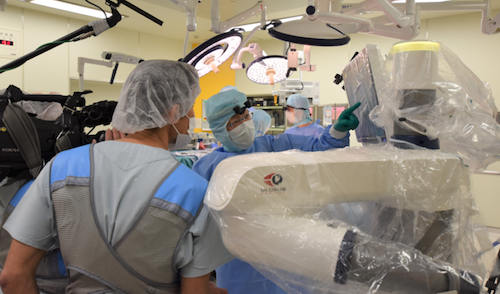Globus Medical has announced expansion to its customer base and successfully integrated ExcelsiusGPS® robotic navigation into two prestigious hospitals in Japan. The revolutionary platform can be found at Toyama University Hospital and Osaka Gyomeikan Hospital. Both sites have successfully completed more than 10 cases.
Prof. Kawaguchi on the Simplicity of ExcelsiusGPS®
Professor Yoshiharu Kawaguchi is chairman of the department of orthopedic surgery at Toyama University Hospital and was the first surgeon to use ExcelsiusGPS® technology in Japan.
“I knew from the first demonstration I experienced that the robotic arm is in fact rigid, the range of movement is wide, and the accuracy is high. The ease of use and simplicity of setup allowed us to move very quickly, enabling the entire OR’s team of surgeons, nurses, and technicians to work efficiently,” said Prof. Kawaguchi.
ExcelsiusGPS®’s rigid robotic arm aligns to the planned trajectory and maintains positioning regardless of the complexity of the procedure. The hardware components make the system easy to store, as well as easy to dock the camera stand into the base station to quickly transfer between ORs.
After his first case, Prof. Kawaguchi concluded, “The case was a success and I’m looking forward to integrating ExcelsiusGPS® into more of my practice and introducing it to my colleagues at Toyama University Hospital.”
Dr. Iwatsuki on Choosing ExcelsiusGPS®
Dr. Koichi Iwatsuki, the director of neurosurgery at Osaka Gyomeikan Hospital, stated, “I purchased ExcelsiusGPS® to improve screw insertion safety and reduce radiation exposure to patients and staff in the OR. ExcelsiusGPS® has a wide range of applications and easy handling and mobility.”
ExcelsiusGPS® is built to continuously improve patient care. By providing unique real-time information, the surgeon can constantly monitor patient movement for accurate trajectory alignment.
Dr. Iwatsuki continued, “we chose this robotic navigation system based on the judgment that it is the best because it enables constant localization using markers, even if the patient’s position changes. We hope that [the system’s] accuracy will make spinal surgery with difficult screw trajectories less invasive.”
Steve LaNeve, Globus Medical’s Executive Vice President, International, on the Acquisitions in Japan
“This success could not have been achieved without both the Toyama University Hospital and Osaka Gyomeikan Hospital teams and the Globus Medical Japan team working in collaboration. This is an exciting step towards providing Japanese patients and surgeons access to this innovative technology,” Steve LaNeve stated.
Both of these hospital systems are leading the way in Japan by utilizing the ExcelsiusGPS® robotic navigation platform and changing the way surgery is done.
Image: Prof. Kawaguchi explains his preoperative plan on ExcelsiusGPS®
Source: Globus Medical.











